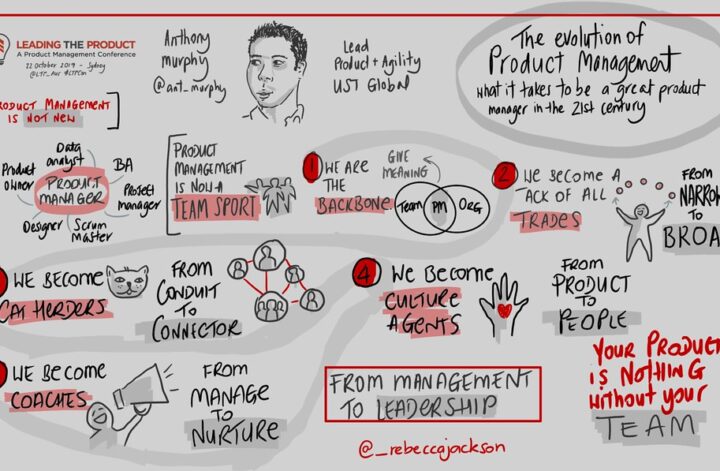Four weeks ago I started a new role as a Senior Product Manager at the BBC.
I really loved working at the Department for Education (DfE) and have a debt of gratitude to the organisation for creating the associate pm role that got me into product in the first place.
But I must say, I’m so made up to be at the BBC.

The BBC fascinates me. I love it and I always have. Like most living in the UK, it’s been an ever constant in my daily life and I’m pretty certain it’s the brand that I’ve trusted the most and spent the most time interacting with.
So to be a part of it, as a senior product manager, in less than three years since I got into product management really is a dream come true for me.
Getting to change roles has allowed me the opportunity to further develop my craft in a different setting to DfE. Will product management be the same in the BBC as it was in government, will I be able to do it? Will I enjoy it as much? All this remains to be seen, but I’m very much looking forward to the journey.
The first thing the role change has encouraged me to navigate is, how do you go about starting a product role within a different organisation? A new challenge for me. I’ve changed roles before but within the safety and familiarity of DfE.
In this article, I’m just going to blog about what I did and what I didn’t do as I started this new role within the BBC’s Design System team more as a chance to reflect. I’m not positioning this as a ‘here’s what you should do to successfully join a new org’, more just sharing what I did in the hope that some of what I say might be helpful for anyone else out there preparing for a brand new PM job.

Recharge the batteries
Firstly, I wanted to make sure I didn’t turn up feeling like I was running on fumes. Between January and February I had been working pretty much flat out at the DfE and could feel I was in need of a break. Luckily, I had 8 days holiday to take before my start date in May and that coincided with King Charles Bank Holiday Bonanzas so I had quite a lot of leave in my final month plus some time between my last day at DfE and start date at the BBC.
I was really grateful for that and felt refreshed and ready to start a new and exciting challenge.
Pre-start prepwork
I may have got the job but what even is a Design System though?
I’d swotted up enough to get through the interview but soon I’d be in the weeds with people that had been working on this for a long time.
Obviously, it’s okay to not be a subject matter expert when you join a new space.
In fact, I think not having a great deal of knowledge on the subject matter can be beneficial to product managers as it encourages you to go full Columbo asking question after question as you build up your understanding (sometimes unearthing things that other people don’t know too).
When I started digging into the Design System space, I found a buzzing community with lots of hugely passionate people. I started periodically checking out loads of blogs, podcasts and books and making a list of thought leaders in the space.
Every now and then I’d email someone that I’d been listening to / reading and ask if they could spare any time to help me build my understanding.
Although being so forward might feel a bit uncomfortable to begin with, my takeaway is that, overall, people are nice and want to help.
I was really blown away with how generous people were with their time and those conversations with either other PMs in the space or general Design System practitioners really helped me to build my confidence and feel like I had a bit of a headstart on getting a feel for the area.
I also feel like I’ve made some allies in the Design System world who I can turn to for objective advice, and hopefully, when I get more up to speed, start helping them with some of their problems/projects too.
Meet the team early
I totally get this isn’t doable in most cases but I was really fortunate in getting to meet people in my team early. I had a long notice period and some of my new team were kind enough to reach out on LinkedIn to say they were excited for me to join. I was made up with that alone but then they took it a step further and asked if I’d like to come into the office and have a coffee and a catch up with some of them.
That was such a lovely experience. They gave me a tour of the BBC (very exciting) and then we spent an hour just getting to know one another. Everyone was so nice and it just really relaxed me, put me at ease and just feeling mega excited to get started and work with such a thoughtful bunch of people.
Actually getting started
After getting set up on systems and sorting my laptop out, the thing I was most keen to do, and what I’d set as my objective for the first two weeks, was to meet as many people as possible.
My line manager had been kind enough to make me a list of suggested people, so using that list of names, plus each member of my team, I went about putting in 30-mins informal coffee catchups with people.
Where possible, I put these meetings in face-to-face. Reason being, there main objective was to get to know people and for them to get to know me. Wonderful things can be achieved via remote working, but personally I feel I connect with people better IRL.
To give these catch ups a bit of structure, in between chatting about everything and nothing, I’d ask three questions to each member of my team.
- What are this team’s superpowers?
- What things could this team improve upon/ what are it’s key challenges?
- What would you like to see me, as product manager, do to help the team?
For those not on my team I didn’t ask the above questions, but instead focussed on finding out about their role and where our roles / teams would interact or overlap. I also asked everyone for their opinions on how we could and should work well together.
I found this period both thrilling and exhausting.
Meeting new colleagues (and hopefully friends) for the first time is really cool.
However, meeting lots of new people, mainly via Zoom, in such a short space of time is also quite mentally tiring – but I wouldn’t change a thing.
I can’t overstate how much emphasis I think should be placed on meeting as many people as you can early on, getting their sense of what’s important, and most importantly – showing people that you’re interested in the work and interested in them. A huge proportion of doing this job effectively relies on personal relationships and you don’t get a second chance to make a first impression.
Start a murder wall

Now as well as a list of people to contact, my line manager also sent me a load of documentation to read through. The documentation was really in depth and useful but on a personal level I find I learn much more from doing or through conversations than I do from reading documents. However, I did read everything I was sent.
As I went through the documents, I also had a Miro board set up as my murder wall.
But what’s a murder wall, I hear you ask? Well, you know on police shows were they take up a whole wall and visually map all the clues, evidence and suspects? It’s basically that but instead of solving a crime you’re trying to piece together the new team / project or problem you’re solving.
As I went through the documentation I used the Miro board to link to all the docs I found useful / interesting and, most importantly, I also collected a load of questions I had about what I’d been reading.
Other things that went on the Miro board included questions I had about how the team operates. For example, one post it note read ‘what are all the ways in which work enters the team?’ I’d also use the board to note down any ideas I had.
At first I had little structure, just dropping down ideas, thoughts or questions as I had them on the board. Structuring these abstract ideas actually helped me come up with a plan of action, which I’ll come to a little later in the blog.
Slow down, don’t be hasty
One thing I think it key is making the most of being new.
No one is expecting you to lead on things, know everything or to be making important decisions as, quite frankly, it would be weird for you to be doing so with so little knowledge of the space.
That being said, there are times when the temptation is there.
You might see a problem you’ve encountered in an old team and know a process that worked there, or have some ideas on what you think backlog refinement should look like. However, I strongly recommend holding off sharing your ideas, or trying to get them implemented too soon.
There are a few reasons for this.
- Keep using this period to meet people and to sponge up new information. If you get into the ‘doing’ it’ll eat into your time in which it is acceptably to just focus on learning – you won’t get this time again so try to get as much value as possible
- There might be good reasons why the team don’t do the thing you think would revolutionise team processes – so take time to find out as much as you can about the context of how they arrived at current ways of working before jumping in
- You haven’t built up trust yet and nobody cares about how your old team did things. I think this point is huge. If you come in like a bull in a China shop – ripping up processes – then the chances are you’re going to put people’s backs up.
- Instead, take the time to slowly build up trust, take on small projects and show you’re adding value. Hopefully then, if you’ve proven you’ve got best intentions and have progressed some things you’ve been involved with, the team will be more open to new ideas.
Start making a plan
Between the documentation, going to meetings, meeting my team and building out my network – plus all the thoughts on my murder wall, I’d started to collect a lot of information and ideas.
After three weeks, the time felt right to start to start leaning more into the doing rather than the learning.
I decided my first port of call would be to theme and group all the questions / ideas on the murder wall.
Quite unexpectedly, what emerged were six quite distinct areas that, when scrutinised, felt like they were either problems to solve, possible processes to introduce or potential opportunities to add value.
From these I formed a small plan of where I think we can improve or introduce new ways of working.
Start communicating as soon as possible
Now, I might have thought the areas I’d outlined seemed like good things for us to be looking at as a team. But did everyone else?
Where there other initiatives they thought were more pressing, was there a reason one of the areas of focus I’d suggested wouldn’t work, or alternatively, would the team be excited about the things in the plan?
Well, there’s only one way to find out…share where you’re at and what you’re thinking and ask for feedback.
So that’s what I did. I created a quick and dirty slide deck in which I…
- Explained that I was giving this update as I believe in working in the open, overcommunicating and eliciting feedback early.
- I played back the overlapping themes that came out of my informal 121s on what the team was good at, where there was room to improve and what people wanted a PM to be doing in this space
- I then went over the murder wall, the questions I had, and then shared the six areas of focus that emerged.
- I then shared what my short-term priorities looked like i.e. the things I’d be doing in the next 6-8 weeks. I followed that by sharing more longer-term ambitions for both myself and the team, things to look to achieve over the next twelve months or so.
- Then, and most importantly, I asked for feedback. This led to some really useful conversations in which the team challenged some of what I said adding the fresh perspectives I’d sought, but also showed excitement regarding some of the opportunities I’d shared.
Move from learning to doing
I’d been really pleased with how the session went. I felt the conversation well and I hoped by playing back what I’d learnt from the 121s I’d shown I’d been actively listening. And also that I’d been taking on people’s opinions and using them to shape a plan. One that I didn’t launch into too early, and one in which I’d returned to them for feedback before putting it into action.
With the team seemingly bought into the short and long-term priorities I’d shared, I now felt like I had a mandate for action and a plan of attack I could refer back to as I came out of my observation phase and ventured into the realm of actively doing.
I’ve really enjoyed being new, meeting people and learning as much as possible and everyone has been super welcoming, which always makes things easier.
But now I feel ready and excited to start putting some of the ideas to practice and hoping they result in improvements for both the team, our users and the business.
I’ll keep you posted on whether that’s the case as the weeks turn to months – so sign up to the newsletter if you’d like to hear more.



